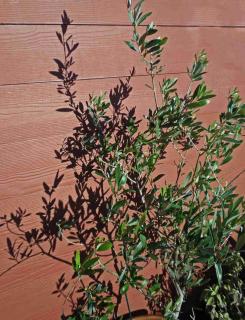

Olive trees in the North? Yes, it can grow! A single thing matters: take great care of the special needs of this exceptional tree.
Part of the Oleaceae family, olive trees are the most typical of Mediterranean trees. The name alone is enough to bring visions of warmth, light and crickets lazily calling on each other during the afternoon nap.
These trees are exceedingly slow to grow, and their longevity is extraordinary.
Their twisted trunks and evergreen leaves with delicate colors of gray and green make these remarkable ornamental trees.
In the Northern parts of our temperate climates, this is the prime appeal of olive trees. Indeed, with short summers, you won’t get any olive harvest!
 Olive trees are perfectly adapted to growing in garden boxes as long as they get full sun and are sheltered from wind. Choose a nice terra cotta pot where you can add a couple lavender plants.
Olive trees are perfectly adapted to growing in garden boxes as long as they get full sun and are sheltered from wind. Choose a nice terra cotta pot where you can add a couple lavender plants.
Olive trees are extremely drought-resistant, and only require moderate watering. They are very comfortable with being transplanted, and this will let you change their pots as soon as you feel the fit is getting tight.
In winter, bring them in a sheltered place like a cool, well-lit, dry room. If not indoors, then make sure they’re sheltered from rain and wind, and against a warm wall.
You can plant your own olive tree in the ground if you can ensure the following environment: Southern exposure, light, dry soil with excellent drainage. You’ll also need to give it some elbowroom – 20 to 25 feet (6 to 8 m) with the trunk in the center – because this trees thrives best when it doesn’t feel crowded.
It abhors moisture and strong wind, but can cope with temperatures down to 5°F (-15°C), as long as the air and soil are dry.
During the first years of your olive trees’ growth, watch out for rabbits! They might come snack on your young trees’ bark, which could be fatal if they reach the core. There are other diseases that might infect your tree, such as the Xylella olive bacteria, so check if this has reached your area yet or not. Also, remember to prune them at the end of winter to shape the trunk into a single stem.
M.-C. H.
Read also:
I have a Olive tree in a pot it is now December and there are still green olives on my tree do I need to take them off or just leave it alone.I live in Cheshire England. Thank you lorraine
Hello Lorraine! Congratulations on your first olive crop! There is no need to take them off yet. Best is to wait for veraison, the point where they leave the green, hard, unripe stage and switch to more mature, softer, yellow-red-or-black color. That’s when you can harvest them and start preparing them. Usually this happens within December. You can then pick them and start preparing them. Remove pits, reduce to a pulp in a blender with a glass of lukewarm water, and then press/filter everything in a bowl through a cheesecloth. Oil and water will then separate, voilà! For the tree, it’s all the same whether you pick them now or later.